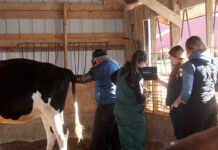MADISON, Wis. — Between 1965 and 1970, graduate students from the University of Wisconsin-Madison and other institutions hit the road to capture the unique character of the way Americans speak. They recorded the words, phrases, pronunciations and pieces of grammar and syntax that vary from one part of the country to another.
That groundbreaking work provided the basis for the “Dictionary of American Regional English” (widely known as DARE), a celebrated reference work that only recently reached the end of the alphabet.
The researchers traveled in Word Wagons, campers specially outfitted with stove, sink and bed, as well as an extensive questionnaire and the reel-to-reel recording device necessary to capture the voices of Americans in more than 1,000 communities across the country.
More research
Only now are DARE researchers heading back into the field for the first time since the original survey was conducted. Fieldwork begins as Harvard University Press prepares to release a digital edition of the dictionary to the public, transforming DARE into an interactive, multimedia tool to benefit researchers and word lovers alike.
The digital edition includes: state-of-the-art search, browsing by region as well as alphabetically, audio from original DARE field recordings, maps illustrating regional distributions, saved searches and entries for easy reference, and explorations of the DARE survey results.
New approach
But unlike 50 years ago, the dictionary won’t be sending out researchers in Word Wagons. This pilot study, funded by a grant from the National Endowment for the Humanities, will use an online survey (https://study.uwsc.wisc.edu/dare/dare.php) rather than face-to-face interviews to trace the ways language has changed, or stayed the same, since the first round of fieldwork was done.
This time, DARE is using a web-based survey, designed in conjunction with the University of Wisconsin Survey Center, to gather data from the original 22 Wisconsin communities where the original fieldwork was done, plus 30 new ones chosen to reflect the state’s current demographics.
The research will include large parts of the original questionnaire plus new questions designed to reflect societal changes since the 1960s.
Original results
After the original fieldwork was done, editors in Madison spent four decades studying the more than 2.3 million responses the fieldworkers had collected, capturing in DARE the diversity and richness of the American language.
The dictionary reached ‘Z’ last year with the publication of its fifth volume, and a supplementary sixth volume came out in January. The digital edition launched Dec. 2.
“Publication of Volume V of DARE was a huge milestone, but not the end of the work,” says Joan Hall, DARE’s chief editor. “American English has changed greatly in the last 50 years.”
The new Wisconsin survey also includes the option of a telephone interview that has participants engage in conversation, read a story and read a word list designed to elicit how they pronounce certain words, such as “bag” and “caramel.”
Hall says the Wisconsin survey is expected to be complete in June 2015. DARE will use the results to make adjustments to the survey’s methodology before attempting to use it nationwide to show changes in language from the original survey.









